Engineering the 2020 Cadillac XT6
Cadillac adds a new model to its SUV lineup, one characterized by “noble elegance.”
#Acura #electronics #interior
Although Cadillac is historically known for its sedans—the legendary tail fins weren’t appended to something that wasn’t low and long—let’s face it: we are in the Age of the SUV, with the XT5 being the brand’s best-seller (meaning the overall best seller for Cadillac) and the Escalade being its image leader. And now, in effect splitting the difference, is the XT6, a three-row SUV that is intended to address the needs (and desires: after all, this is a luxury vehicle* and needs can be quite nicely fulfilled by a Chevy) of families, as it offers seating for seven and an array of amenities for both comfort and safety.

One of the features of the Cadillac XT6 that distinguishes it from the XT4, XT5 and Escalade is that whereas their lighting signatures have a vertical orientation, the XT6 has that horizontal lamp that provides something of, in the phrase of Robin Krieg, lead exterior designer, “understated aggressiveness.”
John Plonka, chief engineer for the XT6, says that there are three areas that they addressed when developing the vehicle:
- Comfort and technology
- Safety and security
- Driving dynamics
As to the first, he says that one of the key issues addressed was noise. Recognize that a luxury vehicle is meant to be something of a sanctuary, and while the owner of a Cadillac CT6-V might be interested in hearing the exhaust note of its 4.2-liter, 550-hp twin-turbo V8, that’s not the case for a vehicle like the XT6, whether it is the Premium Luxury model or the Sport.
So they deployed an array of countermeasures to minimize noise, whether from the road, powertrain or wind. Things like inner and outer dash mats, shock tower absorbers, A-pillar plugs, D-pillar and rear-end acoustic patches, driver and passenger side hush panels, HVAC duct absorber, as well as tuning the acoustics of things including the hinge pillar and top pad of the instrument panel.
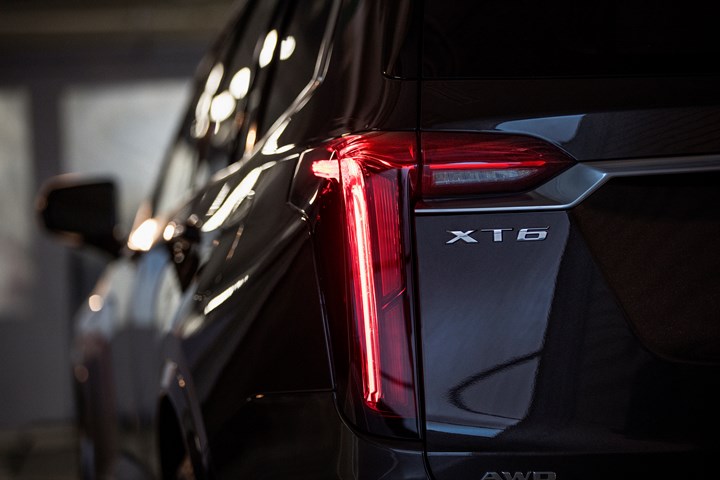
The XT6 Premium Luxury trim features red taillamp lenses. That model is characterized by brightness and jewelry, whereas the Sport model is more understated in the execution of exterior details.
One of the technologies is a Bose audio system that features specially designed stainless-steel speaker grilles for all four doors.
Also in this space are things like Near Field Communication (NFC) for easier phone pairing, Type A and Type C USB connectivity (there are six ports in all), wireless charging, and a rotary controller with a jog function to help the driver use the UX on the 8-inch diagonal color touchscreen: not only can the knurled knob be rotated, but it can be tilted so as to move between items on the screen. And it should be noted that there are also physical buttons both on the steering wheel and the instrument panel, recognizing that while drivers may expect to have as an up-to-date experience with their vehicle as they do with their smartphones, there is am ergonomic difference between something that weighs a few ounces and something that ways some two-and-a-half tons (iPhone XS Max: 7.34 ounces; XT6 Sport AWD: 4,690 pounds).
In the safety and security category, Plonka points to a long list of standard driver assistance and safety features, including forward collision alert, following distance indicator, front pedestrian braking, low-speed forward automatic braking, front and rear part assist, rear cross-traffic alert, lane departure warning, lane keep assist, side blind zone alert. . .yes, a lot, and then some. According to Plonka there is a suite of sensors used for the vehicle, including both long- and short-range radars and cameras both fore and aft.
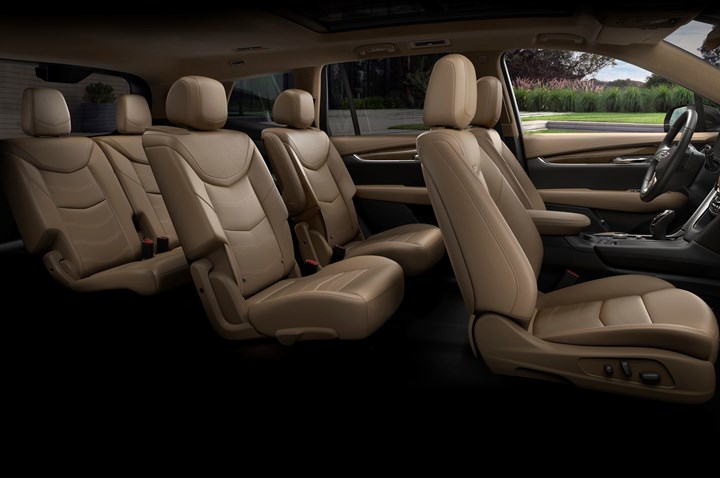
There are three rows of seats in the XT6, with the third row actually providing more room and comfort than is often the case in vehicles of this size.
There is also an available infrared camera that goes with the available Night Vision system. During night driving there is a 4.2-inch rectangular screen in the instrument cluster between the tach and the speedo that shows a black-and-white image of the scene in front of the vehicle but which puts highlighted boxes around any humans or animals that are in the field of view.
Finally, driving dynamics.
Recognize that this is a somewhat sizable vehicle, with an overall length of 198.8 inches, a wheelbase of 112.7 inches, a width of 77.3 inches, and a height (absent the luggage rack) of 68.9 inches. And there is that aforementioned mass (although the Premium Luxury FWD version is a slightly slimmer 4,441 pounds). So, again, the dynamics that Plonka is talking about are not those of a CT6-V.
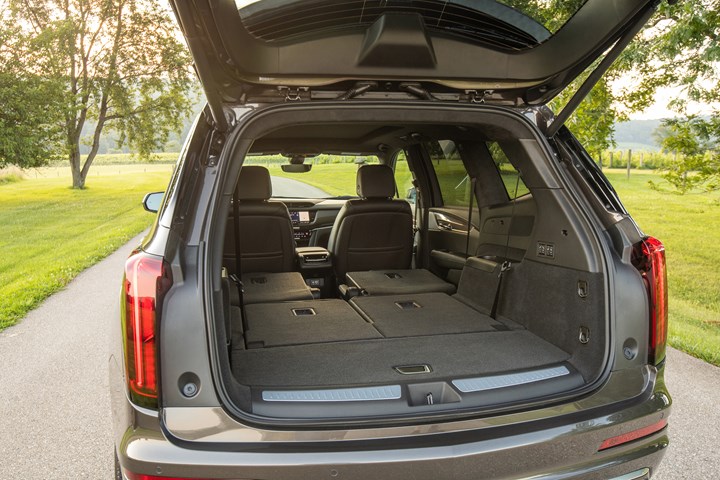
Of course, an SUV has to have utility, which generally means cargo capacity. With the second and third rows folded the XT6 has 78.7-cubic feet of cargo volume; if all the rows are up, 12.6.
He says that the term they use to describe the ride character is “Isolated Precision.” On the one hand, there is the ability to be “confident in driving in a spirited way,” yet on the other, “isolated from things on the road”—like potholes—“but still feeling connected.”
As regards the chassis setup, the front uses MacPherson struts with a direct-acting stabilizer bar; in the rear it is a five-link independent setup, coil springs and stabilizer bar. The Sport model offers standard continuous damping control. (The Sport variant also offers what is called “Sport Control AWD with Active Yaw Control,” which have electronically controlled twin clutches on both sides of the rear drive module and between the half-shafts such that there is independent control of the left and right rear wheels, which provides better handling in curves, as in putting more torque to the outside rear wheel when going into curve and then equally distributing the torque when exiting.)
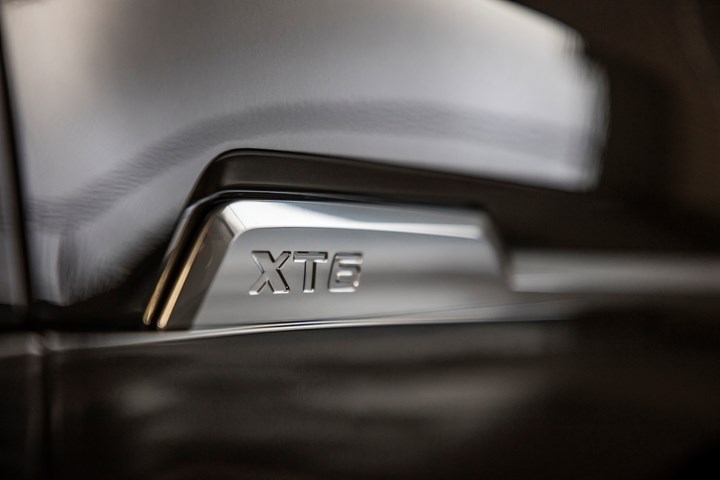
“We paid a lot of attention to the details in developing the interior of the XT6,” says Gary Mack, lead creative designer, Cadillac Interiors.
The propulsion system for the XT6 is based on a nine-speed Hydra-Matic transmission and a 3.6-liter V6 engine with variable valve timing and direct injection. The all-aluminum engine provides 310 hp at 6,600 rpm and 271 lb-ft of torque at 5,000 rpm.
The XT6 is being manufactured at the now-venerable Spring Hill Manufacturing facility in Tennessee (Why venerable? Because it has been in production since 1990.)
The XT6 is in good company there, as it is being built along with the Cadillac XT5 and the GMC Acadia, vehicles that share more than a few strands of fundamental vehicular DNA.
Designing the 2020 Cadillac XT6
Robin Krieg is a lead exterior designer at Cadillac. He had the lead on the XT4, which was introduced in 2018. He had the lead on the XT6. And he’s also worked on the XT5 and the Escalade.
This is important to note not only vis-à-vis his bona fides as regards Cadillac SUV design, but to go to a point that he makes about the design development of the XT6: “We did this one pretty quickly. We’ve gotten our process going a lot faster.”
Krieg says that the usual amount of time required for the design of something like the XT6 would be three years. But for this vehicle, they did it in about half the time.
How?
Because, Krieg says, the team of designers who worked on the vehicle all had experience with SUVs. This allowed them to raise and resolve issues quickly. Because they knew what roles the other SUVs in the Cadillac lineup play, they were able to find the solutions for the XT6 more quickly.
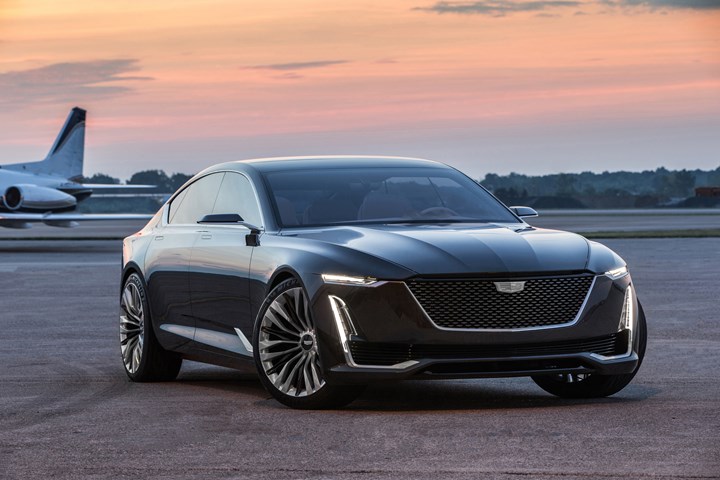
No, this is not the XT6 but the Cadillac Escala concept. According to Robin Krieg, the XT6 has “a strong reference back to the Escala. That car also has a mature elegance.”
While Krieg acknowledges that computer-aided design tools allows work to be done more quickly, “good communications within a small, tight team is invaluable.”
(And while on the subject of technology, Krieg says, “In the studio we still do clay models,” explaining that while virtual reality tools provides some help, there is nothing like “running your hand across a surface.” They use CAD data to mill models—but then have sculptors come in and massage that model, which, in turn, is scanned. “Physical models aren’t going away anytime soon,” Krieg says.)
Krieg says that the design team worked closely with the folks in engineering. “We’re looking at the sheet metal radii and the gaps. We want to make sure that we’re getting the fit and finish that’s appropriate for this class—and that never stops moving. We’re always chasing higher levels of execution.”
Of the Cadillac SUV models, Krieg says that the XT6 is “the most mature.” He describes it as having “noble elegance.”
That said, there are two versions of the car: Premium Luxury and Sport.
As for the former, Krieg says that on a macro level the Premium Luxury version is “about details and showing off the jewelry.” There is brighter trim. As on the grille, where hot-foil stamping is used to provide a metallic look, a Galvano finish (a finish that is also used for the side window moldings and roof rails). The taillight lenses are red.
As for the Sport model, it is “more serious,” with a darker treatment overall. For example, the grille (which features a design that is inspired by the V-Series), is black, as are the window moldings and roof rails. The taillight lenses are clear.
“A good design should look like what it does,” Krieg says.
*Bob Benbow, marketing manager of XT6 and Escalade, makes an interesting point about the segment that the XT6 fits into: “The segment is not dominated by Mercedes or Audi.” The competitor that comes up the most from Cadillac people is the Acura MDX, although there are other competitive vehicles in the space, such as the BMW X5 and the Volvo XC90. Benbow says that one of the segments they’re addressing consists of people who are 38 to 50 years old with children. One of the people they interviewed during a market exploration clinic was a woman who described herself as “the CEO of Everything,” meaning that she has a busy life inside and outside the home, and that a vehicle like the XT6 was a reward for her hard work.
RELATED CONTENT
-
NACTOY Finalists Announced
The finalists for the North American Car, Utility and Truck of the Year (NACTOY) awards were announced at the Los Angeles Auto Show today, and because the choices are essentially based on choices predicated on design and engineering (after all, as the jurors drive the vehicles, it isn’t an issue of sales or marketing), the selections of the three finalists in each category can be considered among the best in class when it comes to those two functions.
-
2021 Honda Accord Hybrid Touring
Where efficiency meets surprising luxury
-
Autoline After Hours in NYC
The 2016 New York International Auto Show is open to the public right now, but last week it was opened just to the press, where several vehicles were introduced, like the 2017 Prius Prime, a plug-in variant of the non-plug-in Prius hybrid.


.jpg;width=70;height=70;mode=crop)